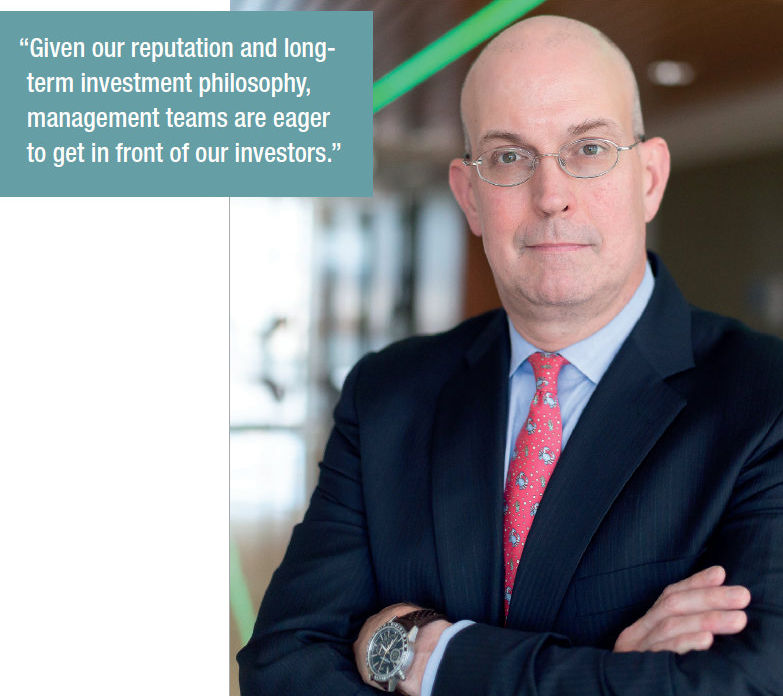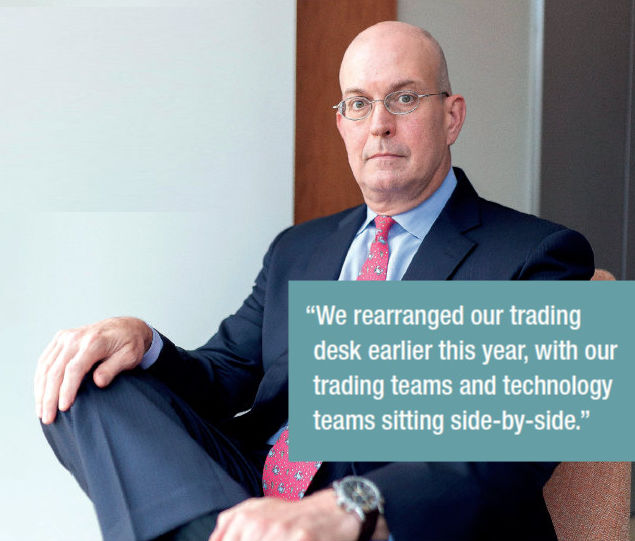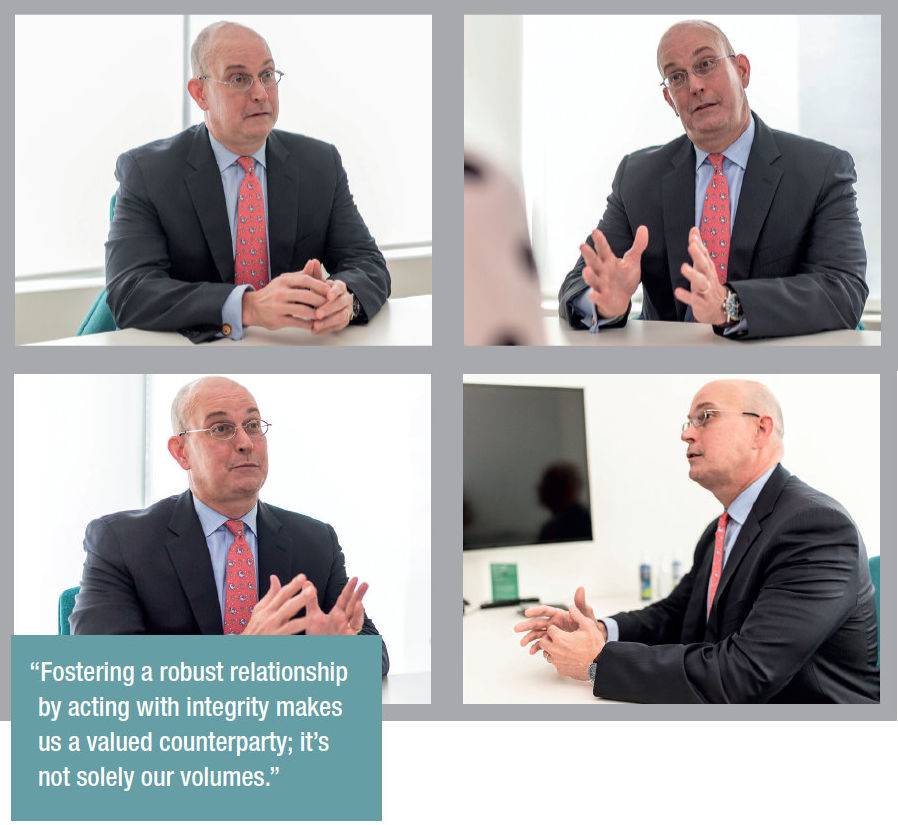Marc Wyatt, head of Global Trading at T. Rowe Price explains why, in an industry under pressure, standing up to your commitments is fundamental to success.
How does the way that the trading desk represents itself to the street impact your ability to deliver?
Our desks work on partnerships every day. The strength of the partnerships determines where we fall in the pecking order with our sell-side counterparties. Like us, sell-side desks have options on who they choose to interact with. Fostering a robust relationship by acting with integrity makes us a valued counterparty; it’s not solely our volumes. We hold our trading partners to a high standard and expect them to be an extension of our desks.
My role is to reinforce those relationships in my meetings with the sell side and recognise when our partners step up to help our clients.
What specifically might presenting well to the street entail?
It’s transparency and consistency, so both sides know how to enhance the partnership. We share what we are looking to accomplish and the expectations for our flow. Part of the partnerships I referenced earlier is providing ongoing feedback – what is working and areas of improvement. We provide biannual trader feedback reports to our sell-side counterparties. These reports are well received and reinforce the daily interactions.
 How does the firm liaise with issuers in primary markets?
How does the firm liaise with issuers in primary markets?
Meeting with management teams is a key part of the investment process and the traders often participate in those meetings. Given our reputation and long-term investment philosophy, management teams are eager to get in front of our investors.
So it’s fair to say traders are more front and centre?
Yes – our traders are a valued part of the investment process. Our portfolio managers and analysts look to us for not only liquidity and execution services, but also for a voice in relative value. The investment teams look to trading to be their eyes and ears in the market and provide insight into market colour and positioning.
Within your teams what sort of changes do you see in terms of make-up and skills?
We have a global team, and a diverse skill set. We have a lot of seasoned traders with deep relationships with the street. Those tenured traders have experience in all types of market conditions and liquidity scenarios. Recently, we supplemented that experience with deep market structure expertise and data teams to help drive our analytics. These areas are becoming increasingly important. Constantly evolving market micro-structure and the exponential growth in data have made these roles essential when striving for best execution.
 Is there a blurring of the lines between technology and trading teams today?
Is there a blurring of the lines between technology and trading teams today?
Indeed. We rearranged our trading desk earlier this year, with our trading teams and technology teams sitting side-by-side. Our technology team spends a lot of time developing solutions to alleviate pressure that the trading team experiences.
The key to our success is the alignment with our technology teams. Dave Whitmore, global head of trading technology, runs that group. We work very closely to make sure his team knows the trading team’s priorities, and the trading team has transparency into the delivery schedule from Dave’s technology resources.
Are your traders becoming more eloquent in using the language of technology?
Yes, they are very educated consumers, and vocal about what needs to be enhanced or changed. Our traders are operating in an evolving landscape and they know which tools or protocols need to be tweaked or overhauled to keep them at top of their game in the work they perform on behalf of our clients. They are never bashful about calling out where a system may be deficient or not fit for purpose. Collaboration and alignment between traders and technologies are key to success.
What is the interaction between trading and the market structure function?
We have a matrix structure. We have high-touch trading by asset class and we supplement that with low-touch expertise. Our low-touch team covers all assets and is run by the global head of systematic trading and market structure, Mehmet Kinak. He has taken lessons from the digitisation of the equity market and applied those, where appropriate, in our fixed income franchise. It’s important to recognise it’s not jamming an equity solution into the various fixed income workflows. It’s electronification of the markets. He works with the trading team to deliver low-touch capabilities as appropriate, and ensures our traders are operating at their highest and best use.
Could you outline how you segment the way that different trading teams are split up by instruments: high touch and low touch?
We have desk specialists who run specific asset classes; high yield, investment grade, emerging markets, structured products, and money markets. They are responsible for driving the trading and execution decisions on those desks. We have supplemented that with Mehmet’s team, who will come into the rates or FX space and look at the processes being used and understand the tools we are using to execute. We come up with ways that we can automate execution, get straight-through-processing via algos or other tools, so they work in partnership.
How would you characterise that interaction going forward?
Data driven. We need to continue to optimise data to drive our trading decisions, and as we just described, to automate appropriately and optimise our routing decisions. Our team is going to drive innovation internally and externally, with our tech teams, trading venues, and technology vendors. With our size, asset coverage, and geographic reach, we will continue to drive the shape of the engagement model to source unique liquidity and ensure data driven decision making which looks holistically at the value of partners and the counterparties we are trading with. It is important that this remains an iterative process.
What changes have you seen in your counterparty selection?
Obviously the biggest change has been the reduction in sell-side balance sheet. Our overall wallet size is not dramatically different this year. Like most firms our size, we have concentration with larger platforms that offer a breadth of services such as balance sheet, clearing capabilities, effective electronic execution platforms, access to emerging liquidity pools like ETFs, portfolio trading, etc. We have some longstanding relationships with those institutions; however, some have chosen to “juniorise” with less experienced talent. That decision can have an adverse impact on the partnership. At the other end of the spectrum there are smaller, often newer counterparties which have a technology edge or a unique franchise in a specific asset class. Data and pre-trade analytics continue to expand across the asset classes and are an important consideration in our counterparty selection process.
Has the number of counterparties changed?
We are not culling our counterparty list. That said, I would expect the industry to naturally evolve. And in that evolution, some will have the scale to survive, others may innovate to stay relevant, and some may not be successful. We are purposely trying to keep our options open and source liquidity on behalf of our investors.
And as far as the non-traditional counterparties go, are you finding that they are a useful addition to the counterparty eco-system?
Competition is good, particularly when innovation is accretive to the ecosystem. The disrupters tend to get copied if they get traction, and sometimes that’s helpful to have some of our established relationships up their game in response.
How are liquidity and pricing formation processes faring at the moment, and are there any changes /optimisations you are working on?
Liquidity is okay today; we have seen pockets of stress, last December for example, but that’s to be expected where we are in the economic and credit cycle. The bigger change appears to be in price formation, which is getting impacted by ETFs, portfolio trading, and more buy-side participants as price makers, or price takers. We must understand what those new price discovery drivers mean in terms of our ability to leverage new or emerging liquidity.
Where have you seen the biggest pressures on execution quality today?
My concern would be misconceptions of what best execution means across the fixed income franchise, from internal customers, investors, consultants, or even the regulators themselves. We strive to address this risk by documenting policies and procedures, measuring and reporting our best execution, and having robust, regular governance. There are a variety of factors that influence best execution and, depending on the market you are in, you will apply different weights to those. It can become “garbage in, garbage out”, meaning data quality is a critical consideration in best execution. It’s important that we empower our trading team to use their experience and judgement to make decisions.
Which technologies are you most interested in today in boosting your team’s performance?
Any technology that optimises our trader’s attention. Technology that minimises the ‘swivel’ required to ingest information. “Keep your head on swivel” is good advice for a wide receiver in American football, but it shouldn’t be needed on a trading desk. We look for technologies that push relevant trading information to our teams and enhance the information quality in every interaction with our traders. Context switching is proven to be detrimental to focus and where we can we are looking for opportunities to use technology to aggregate, alert, and, in general, help separate the signal from the noise.
Do you think there are gaps in service from technology data and platform providers?
Two types of providers are emerging. Global end-to-end platforms, and then niche players that are trying to solve unique problems in a variety of asset classes. Each of our desks has unique characteristics, and we are looking for modular solutions or platforms that leverage industry standards for data but can provide customisation as appropriate. The ‘gaps’ can be in ease of execution and co-existence in the existing stack of solutions, as much as in the solution they are providing. Integration with existing stack is an ongoing challenge to levering a best-of-breed approach.
 How do you describe the value trading delivers to investors?
How do you describe the value trading delivers to investors?
Our trading teams are valued partners in the investment process with our portfolio managers and analysts. They provide input into instrument selection and portfolio construction. Our clients are increasingly meeting with the trading teams to understand their process and their views on current market issues. Traders provide insight into how they use execution venues to minimise market impact, so clients come away with a better appreciation of how trading can enhance the alpha that investment teams generate on their behalf.
What are the greatest challenges your traders face, and as head of trading what can you do to help them?
Overall our traders are resilient and mission-focused. The pace of change is the most common challenge. And that change is coming from market structure, regulatory changes, technology, changes in counterparties, new markets, new products, etc. Given competing priorities, we can’t solve every challenge immediately, but we can prioritise and execute with our resources. We want to make sure we provide the team with an appropriate intake mechanism and transparency, so they know that we appreciate their issues, and we give them insight into how we are going to get them resources to address those challenges.
Biography:
©The DESK 2019
©Markets Media Europe 2025




















